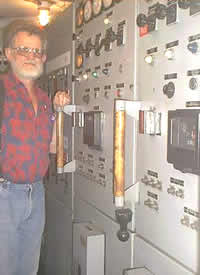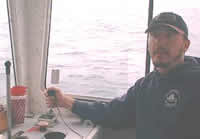| |
| |

Engineer Duane Leafdahl in the depths of
the ship next to the controls that operate the ship.

Able Bodied Mariner (AB) James Turley working the winch from the "dog
house" on the deck.
|
|
Teacher Logbook - R/V Wecoma
Missy
Holzer 's Sealog:
CTD Cruise Day 12
Weather at 1630 hours PDT:
Overcast skies with winds of 20 knots from the
west, and visibility of 4 miles. Barometric pressure is 1022.9, and the
temperature is 58 degrees Fahrenheit. Ocean swells are 6 feet out of the
northwest, and the seas are 5 feet out of the northwest.
Staying on
your toes (figuratively!) is one of the requirements of being out at sea:
aware of your surroundings on board as well as in the ocean. Lately if
it weren't for an alert crew, the "fish" and all it's instruments
would have jettisoned to the depths numerous times due to a problematic
winch. The engineers and deck crew are responsible for maintaining the
performance of the equipment on board the R/V Wecoma, where troubleshooting
during a crisis is in their realm of expertise.
Maintaining
the mechanical and electrical aspects of the ship belongs to someone well
versed in all areas of mechanics since they are responsible for the engine,
the air circulation, the plumbing, making fresh water, etc. On the R/V
Wecoma there is a Chief Engineer, and 2 additional engineers to see to
it that everything mechanical and electrical used to keep the ship afloat,
moving, and operating efficiently are in proper working order. The R/V
Wecoma has two 300 horsepower generators that put out 300 kilowatts of
energy each. The main engine is 3000 HP, and has 16 cylinders that use
85 to 100 gals of fuel per hour when maintaining a cruising speed of 12
knots. The fuel tank holds about 59,000 gals of fuel and will use up 180
gal per hour when it maintains a speed of 14 knots. The R/V Wecoma can
make it's own fresh water at a rate of 100 gal per hour when it's on a
long cruise, and has done so already on the NeMO CTD Cruise.
A tour of
the depths of the ship takes you down through layer after layer of parts
that make the ship "go" and function properly. From hearing
the names of the parts like cylinders, transmission, oil filter, etc.
you feel as if you are walking through a huge car engine. To complicate
this "car engine" all the comfort systems (fresh water, air
circulation, refrigeration, etc.) are interspersed in between the car
parts. Another interesting aspect of the tour is the realization of what
keeps the ship balanced in the water - ballast. In the case of the R/V
Wecoma, the fuel acts as ballast along with seawater, where the fluids
are constantly being shifted to stabilize the ship as the fuel is used.
Another group
that sees to it the ship is running smoothly is the deck crew consisting
of the Boatswain (now called a Bosun) and the Able Bodied Mariners (AB's
for short). These skilled workers are never bored as they are constantly
moving about the ship making repairs, helping out at the helm, and aiding
the science staff in the operation of the equipment. R/V Wecoma Bosun
Doug Andrews says that "a piece of steel on salt water is never maintenance
free, and therefore there is always something that needs to be done."
Between the engineers and the deck crew of the R/V Wecoma, the ship is
in great hands since these crewmembers are licensed and carry numerous
certifications to perform their respective jobs. But most important is
their numerous years of experience and keen perception to the nuances
of the ship that make the R/V Wecoma a safe and efficient vessel.
|
|

